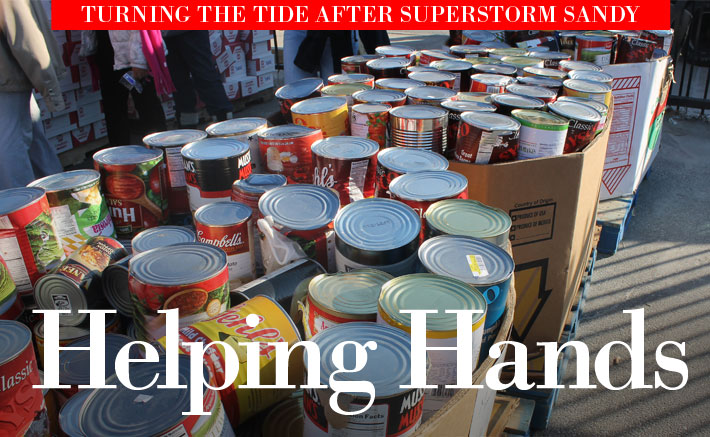“Once Cablevision bought the newspaper, it stopped being an actual newspaper,” she says. “Now, what I mean by that is, News12 is a newsroom, that’s true. But in reality, News12 is the marketing for Cablevision. So, when Cablevision bought Newsday, they created what they call the Newsday Media Group. Expect that to become their marketing department.”
She continues: “So, while yes, they do put out, what is a newspaper, and they can provide some value, at the end of the day, you’re not talking about an organization that’s devoted to serving the public anymore. You’re talking about an organization that is doing what it’s got to do to protect its business.”
Clement says she’s hearing it from Newsday employees themselves:
“I’m told in the newsroom their hands are tied, in terms of what they can now print, in terms of news stories, about competition in the cable industry, that those stories need to be approved by management now. Yeah, so there is no Freedom of the Press there on certain issues. So they’re doing what they need to do to protect their franchise. Which again goes back to—this is a marketing institution now, it’s not a newspaper.”

Local 406 members at Newsday have been wearing this button in a concerted show of support and solidarity for each other while the terms of a new contract are hashed out.
It’s no secret that Cablevision refuses to run ads of competing telecommunications company Verizon. For employees facing possible termination, however, this is another tough pill to swallow.
“We understand that’s a business decision, at the same time, we’re kind of paying for that business decision,” explains Dowdy. “That’s advertising that would help Newsday’s bottom line… That would help Newsday’s bottom line and Cablevision’s bottom line.”
Yet while suspicious hires and the flat-out refusal of purportedly much-needed revenue have many on Long Island scratching their heads, other business decisions of the Dolans have had many throughout the entire newspaper industry doing the same: specifically regarding a costly redesign that seems to have alienated users and a pay wall that so far, has been all wall, no pay.
ANOTHER BRICK IN THE WALL
It was almost a year ago to the day—on Feb. 26, 2009—that Newsday announced it would put its website, Newsday.com, behind a pay wall, and it was almost exactly eight months later, on Oct. 28 of last year, that the shift occurred. The Newsday model was (and remains) fairly simple: Subscribers to Cablevision’s Optimum Online package would be able to access Newsday.com at no extra cost; subscribers to the print edition of Newsday would be able to access Newsday.com at no extra cost; everyone else would have to pay $5 a week, or $260 a year, to read Newsday on the Web.
It was a development that sent shockwaves throughout the industry: While many daily newspapers have threatened to move their online content behind a pay wall, only a very disparate few have done so, largely because it has yet to be proven that pay walls will work, or even can work. For instance, starting in September 2005, The New York Times put a portion of its online editorial content behind a pay wall—what it called TimesSelect—but the paper removed the wall after exactly two years, because executives believed greater revenue opportunities could be mined without such barriers in place. Almost no other comparable examples exist. (The Wall Street Journal, one of the only major news organizations currently successfully charging for online content, can hardly be considered comparable: For all its mainstream content, it’s still a niche publication for the financial sector with a determinable return on investment.)
As such, the Newsday pay wall was big news: It is being monitored closely by media analysts. Yet, unlike many other publications, Newsday.com’s pay wall was not constructed to bring in revenue via Newsday.com subscriptions. Cablevision put up the wall to protect its cable boxes.
One of the first to point this out was Newsday sports columnist Ken Davidoff, who, seemingly encouraged by the move, published a thoughtful blog entry Oct. 27 on the subject, illuminating Cablevision’s master plan. Cablevision was not trying to make a profit from Newsday.com subscriptions, explained Davidoff; Cablevision was using Newsday.com as an enticement to Optimum subscribers to stick with Optimum, rather than move to the encroaching competitor Verizon.
Wrote Davidoff: “That Newsday.com happens to be a newspaper entity is only mildly relevant. Cablevision might be doing the same play if we made bacon, rather than a newspaper. It’s very simple: ‘You can use our competitor for Internet service and pay an extremely high price for Newsday.com (or, Newsday brand bacon), or you can use our Internet service and get Newsday.com (or, Newsday brand bacon) for free.’ If you like Newsday.com even a little bit, why wouldn’t you just use Optimum Online?
“Unquestionably, a worker bee like myself takes a hit,” he continued. “It’s going to be more difficult to expand my own brand name, if you will, if my stuff here isn’t getting linked by other blogs— But that’s not Cablevision’s problem. It shouldn’t be. If my career suffers some, then I feel better about my job. Because I like the fact that Cablevision views Newsday as an asset, and looked [at] a situation that no one besides the Wall Street Journal has solved—how to make good use of online newspaper content—and is trying something different.”
However, not everyone felt so good about the select access. On Oct. 30, in a letter published on the media blog Romenesko, longtime Newsday columnist Saul Friedman announced his resignation from Newsday, prompted by the pay wall.
Said Freidman: “After 13 years of writing ‘Gray Matters’ for Newsday and the McClatchy Trib service, and more than 50 years in newspaper journalism (for Knight-Ridder and Newsday), I have severed relations with Newsday…The main reason: The new owners of Newsday, Cablevision, have shut off access to its website, even to me. It is available only to Newsday subscribers or to subscribers to Cablevision’s ISP. Thus I cannot send my columns to people who don’t subscribe to Newsday. And if it is picked up by Google or Yahoo, it would not be accessible.”
The Newsday waters continued to appear murky and unsettled, and on Jan. 26 of this year, new information emerged that perhaps made Cablevision’s pay wall decision even cloudier. A story in The New York Observer revealed that after three months behind the wall, Newsday.com had signed up 35 new subscribers. Only 35 new subscribers, or, as the piece put in context, “As in a decent-sized elementary-school class.” (By way of comparison—to the extent the two entities can be compared—when TimesSelect shut down, it reportedly had 227,000 online-only paid subscriptions.) Again, the industry was rocked by the news coming out of Melville. The number 35 was bandied about on message boards, blogs and Twitter like the punch line to a particularly bad joke.





